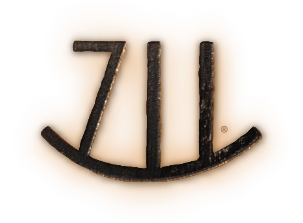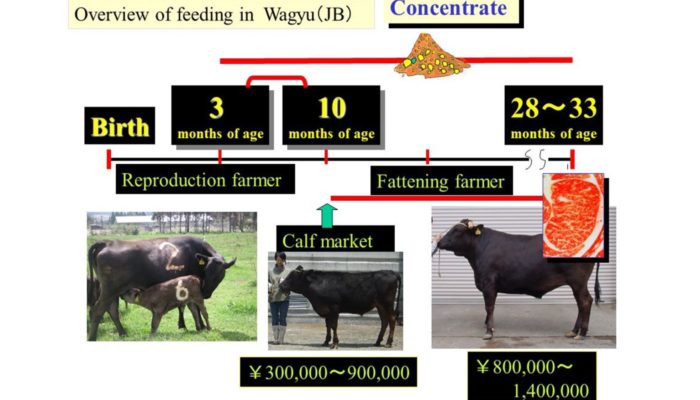The History And Development Of Wagyu Cattle In Japan
Wagyu is technically classified as a Bos Taurus type of cattle. But Wagyu are meaningfully different in many respects compared to other types of Bos Taurus cattle including the British and Contenental breeds. Historians had commonly believed that all cattle breeds originated from three types of large, black European wild ox known as aurochs—one from Africa, one from the Near East and one from Europe. The isolation of a 4th haplogroup in Japanese cattle has led to the view that a previously unknown domestication occurred in North East Asia 4-5,000 years ago.
Because the admixture coefficient divergence between Wagyu and the European Bos taurus breeds exceeds the variation between dairy and beef breeds, a North East Asia domestication has been theorized. There is some evidence of genetic separation into the Wagyu genetic strain as far back as 35,000 years ago.
History records that early immigrants first introduced cattle to Japan between the years 500BC and 300AD as domestic animals from the Asian continent. It is believed that cattle were brought to Japan from China via the Korean peninsula.
In 1830 “Tsuru-ushi”—a breed improvement system—was developed in the Chugoku Mountain region of west Japan. Tsuru-ushi was based on a social system where the head of a village, referred to as a “Shoya” controlled the breeding sires to which tenant farmers brought their cows. The system was common across Japan, especially in the Chugoku region. Under the Tsuru-ushi system these Shoya developed the first inbred bloodlines—originally bred for draft purposes.
Cattle were used as beasts of burden in Japan until relatively recently because Buddhist leaders prohibited the eating of meat. Interestingly enough, breeding decisions were made solely on maternal traits as records were only kept of dams, and because the owners of dams utilized the breeding services of the sires controlled by the Shoya under the Tsuru-ushi system.
The Japanese began eating of beef during the Meiji Restoration, which started in 1867 when the ban on eating meat was lifted. Prior to this time, selection of the native cattle for breeding had been based upon working performance and not for milk or meat production. Soon after the beginning of the Meiji Restoration, when the government wanted to introduce Western food habits and culture, a decision was made by the Japanese government to introduce “improved” breeds of cattle in order to increase body size and milk production. Brown Swiss, Devon, Shorthorn, Simmental, Ayrshire, and Korean cattle were imported starting in 1868. Approximately 2,600 head of British and Continental breeds were introduced in a ten year period and crossed with the native cattle in certain prefectures of Japan.
However, even after the ban on consumption of beef was lifted, cattle were still mainly bred and used for beast of burden purposes. By 1910 the crossbred cattle were considered inferior for work purposes so crossbreeding ceased. While some improvement had been seen in size and milk yield, work productivity and meat quality had deteriorated.
By 1910 the major “breeds” or “strains” of Wagyu in Japan had been established. They are all derived from native Japanese cattle that had been crossed with imported breeds to improve size. The four “breeds” or “strains” that are considered Wagyu are Japanese Black, Japanese Brown, Japanese Polled and Japanese Shorthorn. There are three major Japanese Black bloodlines—Tajima, Fujiyoshi and Kedaka. The different strains of Wagyu, as well as the different bloodlines within the strains, evolved differently due to regional geographic isolation in Japan and selective breeding for different purposes in different prefectures within Japan. There is debate as to whether or not the native Japanese cattle from which the red hided animals developed in Kochi and Kumamoto prefectures were red hided or if black hided native cattle were selectively bred for the red hide.
There are only two isolated populations of native cattle in existence in Japan today, both black hided, but they are not classified as Wagyu in Japan. The wild cattle on Mishima Island—which in 2000 numbered only 100 head—have never been crossed with modern European breeds. They are small in size with a good temperament. The 2nd group of wild cattle is on Kuchinoshima Island.
In 1919 the Japanese government introduced registration and selection procedures. However, each prefecture within Japan implemented their own separate breeding objectives—a throwback to the feudal age. The Japanese government then nationalized the registration process in 1944 and formally recognized three of the four major breeds. The Japanese Shorthorn was not formally established as such until 1957.
Breeding unions were started at village, town and county level and committees determined which sires were used on each dam. Desired traits in the selection process included a soft and elastic hide, fine, soft hair, fine textured horn and clean cut face.
After industrialization reduced the need for cattle as beasts of burden after the 1950s, the focus on beef production changed. Until then the selection process had been mainly focused on body size and growth rate. Performance and progeny testing was started in 1968. Young bulls with good growth had their progeny performance tested. In 1998 carcasses were cut at the 6th to 7th rib section, enabling progeny testing nationally in the field.
The breeding of Wagyu beef in Japan is highly regulated. Progeny testing is mandatory. Only the very best proven genetics are kept for breeding. Zenwa is the government entity in Japan that oversees the Wagyu registry for the four breeds of Wagyu in Japan. After the genetics of only 221 Wagyu were exported from Japan—realizing the value of their unique product—the Japanese government banned the export of Wagyu in the late 1990’s and declared Wagyu a national treasure.

